Language
67 Solves & 84 Attempts
- SHALE
Solvers looking up the given words will quickly run into ambiguity over which language they are. For example, the “detect language” function on Google Translate identifies some of the words as coming from different languages: 銀貨 is identified as Japanese while 椅子 is identified as Chinese. Their Wikitionary entries also have more than one section, because there are different ways to read the characters according to which language is being used.
The only three viable languages are Chinese, Korean and Japanese. The similarities and differences between their romanisations are represented by the Venn diagrams, with the letters exclusive to each language given. Based on these, solvers can identify that Chinese is represented by blue, Korean green, and Japanese pink.
The words are also arranged in alphabetical order of their English translation.
The completed Venn diagrams are:
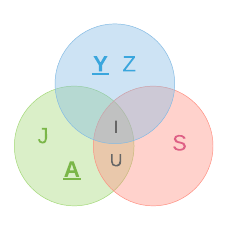 |
椅子 |
| yizi | |
| uija | |
| isu | |
| chair |
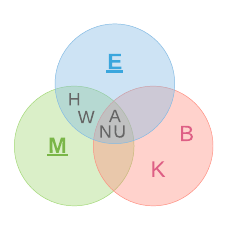 |
文化 |
| wenhua | |
| munhwa | |
| bunka | |
| culture |
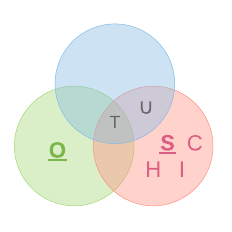 |
土 |
| tu | |
| to | |
| tsuchi | |
| earth |
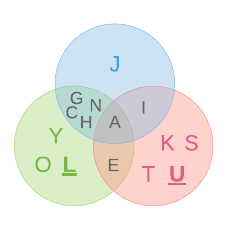 |
警察 |
| jingcha | |
| gyeongchal | |
| keisatsu | |
| police |
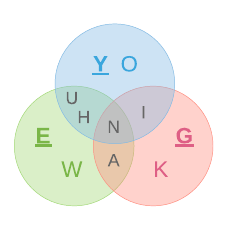 |
銀貨 |
| yinhuo | |
| eunhwa | |
| ginka | |
| silver coin |
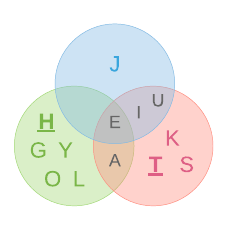 |
解決 |
| jiejue | |
| haegyeol | |
| kaiketsu | |
| solution |
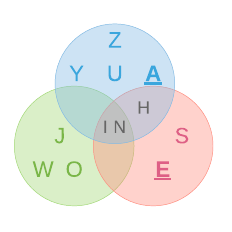 |
支援 |
| zhiyuan | |
| jiwon | |
| shien | |
| support |
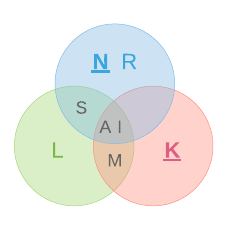 |
三日 |
| sanri | |
| samil | |
| mikka | |
| three days |
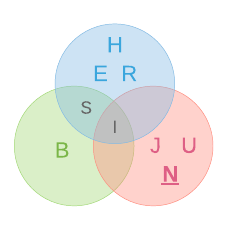 |
十二 |
| shier | |
| sibi | |
| juuni | |
| twelve |
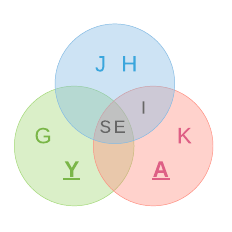 |
世界 |
| shijie | |
| segye | |
| sekai | |
| world |
| Chinese | ||||
|---|---|---|---|---|
| Y | E | Y | A | N |
| 1 | 2 | 3 | 4 | 5 |
| 銀貨 | 文化 | 椅子 | 支援 | 三日 |
| Korean | ||||||
|---|---|---|---|---|---|---|
| H | Y | E | O | L | A | M |
| 1 | 2 | 3 | 4 | 5 | 6 | 7 |
| 解決 | 世界 | 銀貨 | 土 | 警察 | 椅子 | 文化 |
| Japanese | |||||||
|---|---|---|---|---|---|---|---|
| K | E | T | S | U | G | A | N |
| 1 | 2 | 3 | 4 | 5 | 6 | 7 | 8 |
| 三日 | 支援 | 解決 | 土 | 警察 | 銀貨 | 世界 | 十二 |
Yeyan, hyeolam and ketsugan are all written 頁岩. The three words mean the same thing when translated to English: SHALE.
Author’s notes
The idea for the puzzle came when I was watching a Korean variety show (the very excellent Crime Scene, a murder mystery game where players have to figure which one of them is the murderer; fans have subtitled it in English so please watch it) and noticed some Korean words were almost identical to the Japanese ones I knew.
I had to avoid several kinds of words when choosing the set. Korean had different ways to transliterate k/g, p/b, and l/r, which might have resulted in some ambiguity. Another way to romanise ō in Japanese is ou, but most solvers wouldn’t know that, so I had to leave out any Japanese word with an ō.
Sometimes words were a little too similar across pairs of languages. This made it hard to isolate an N in Japanese, for instance. And some words were in Japanese and Chinese but not Korean, or Chinese and Korean but not Japanese, etc.
Relying on Google Translate -- presumably the tool most solvers would use at the beginning -- was also tricky because their Korean translation database doesn’t seem to be as developed as their Chinese and Japanese ones.
I briefly considered adding Vietnamese, which also uses Chinese-style characters, but gave up immediately because Vietnamese romanisation is too different from the other three.